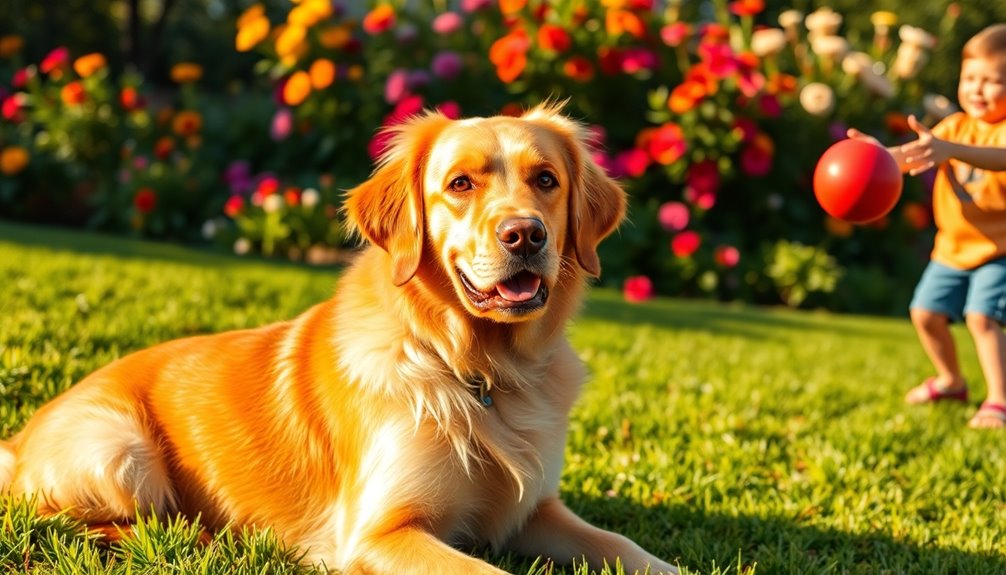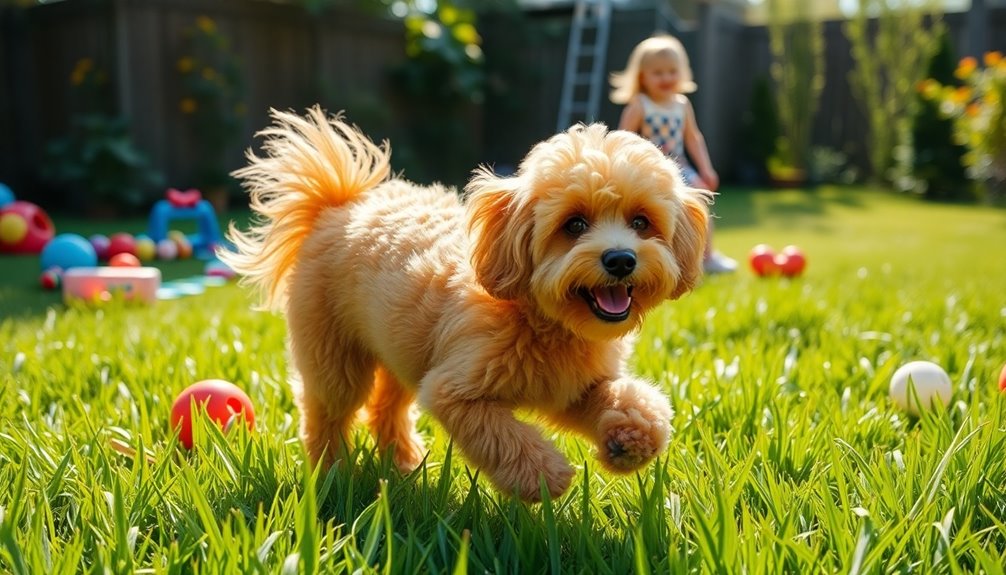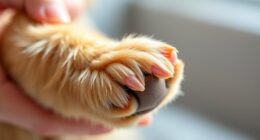The Lhasa Apso is your perfect combination of regal charm and loyal companionship. Standing at just 10-11 inches tall, this small yet sturdy breed features a long, silky double coat that needs daily grooming. Originating in Tibet, they were once guardians of monasteries and royal companions. With their playful yet protective nature, Lhasa Apsos form strong bonds with their families, offering vigilance and affection. They require moderate exercise and adapt well to various living situations, including apartments. You'll discover more about their unique traits and care needs as you explore further.
Key Takeaways
- Lhasa Apso dogs are compact, weighing 12-18 pounds with a long, silky coat, making them a visually regal breed.
- Originating in Tibet, they served as guardians of monasteries and were cherished by Dalai Lamas, symbolizing luck and fortune.
- Their loyal and protective nature makes them vigilant guardians, forming strong bonds with family members.
- With moderate exercise needs, they adapt well to various living situations, including apartments, and enjoy playful interactions.
- Regular grooming and training, utilizing positive reinforcement, are essential for maintaining their health and good behavior.
Introduction
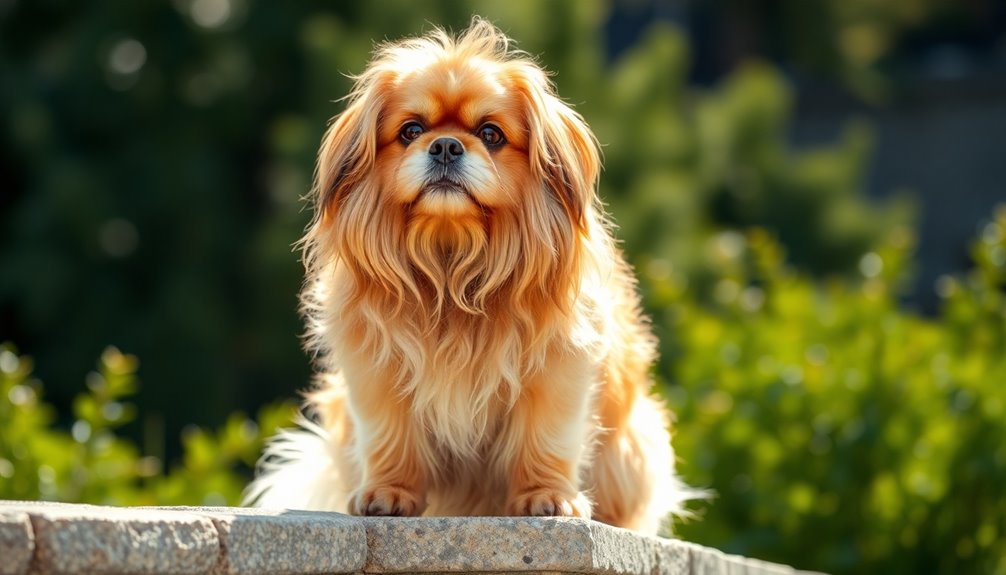
The Lhasa Apso, with its regal appearance and loyal nature, makes an exceptional companion for those who appreciate a small yet spirited dog. Standing at about 10 to 11 inches tall and weighing between 12 to 18 pounds, this breed is compact but undeniably striking. Its long, silky coat, which can be found in various colors, adds to its charm.
With well-feathered ears and a curled tail carried over the back, the Lhasa Apso has a distinctive look that truly stands out. Grooming is essential to maintain this dog's beauty, as it requires daily brushing and regular bathing to keep its coat healthy. This breed is known for being hypoallergenic, making it a suitable choice for those who suffer from allergies.
You'll find that this breed forms strong bonds with its family, showcasing a high level of affection and loyalty. While it may be somewhat reserved around strangers, its protective nature makes it an excellent watchdog.
With medium exercise needs, a few short walks or play sessions will keep your Lhasa Apso happy and healthy. Plus, being hypoallergenic, they're a great choice for allergy sufferers. Just be mindful of their socialization to prevent any 'small dog syndrome' tendencies.
History and Origin
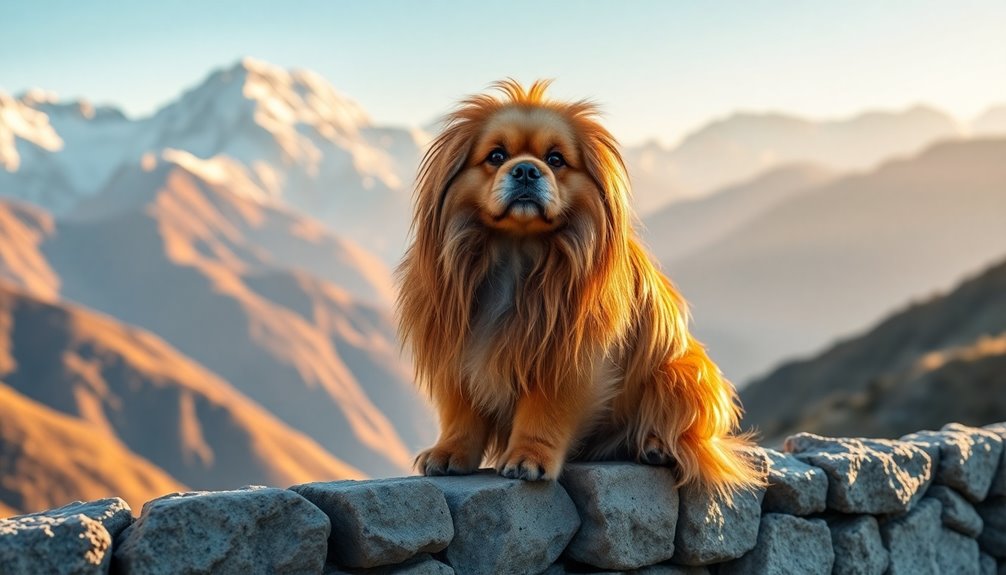
The Lhasa Apso has its roots in Tibet, dating back over 1,000 years, where it served as a sentinel in monastic temples. You'll find that these dogs were bred specifically to guard the interiors of Buddhist monasteries, ensuring safety while larger breeds stood watch outside. Their regal presence and loyal nature made them invaluable companions within Tibetan culture. These dogs are considered sacred within Tibetan Buddhism due to their role as guardians of spirituality.
Where and when the breed originated
Originating in the isolated Himalayan Mountains, Lhasa Apsos have a rich history that dates back over a thousand years. This breed hails from Tibet, specifically the city of Lhasa, which is the capital of the region. Bred and raised in the harsh, cold climate of Tibet, these dogs were deeply influenced by Tibetan culture and Buddhism. Their existence can be traced back as early as 800 BC, with records confirming their presence by 800 A.D.
For centuries, Lhasa Apsos remained isolated within Tibet until the early 20th century when they were first introduced to the Western world. In 1933, C. Suydam Cutting brought the first American pair of Lhasa Apsos to the U.S., a gift from the 13th Dalai Lama. Notably, the breed was historically valued for its role as a protector and sentinel in Tibetan households.
Initially referred to as "Lhasa Terriers," they gained official recognition by the American Kennel Club (AKC) in 1935. Over time, they were reclassified from the Terrier Group to the Non-Sporting Group in 1959, further establishing their unique identity.
Today, Lhasa Apsos are recognized by kennel clubs worldwide, including the Fédération Cynologique Internationale (FCI) and The Kennel Club in the UK.
Monastic Temple Sentinel
Throughout history, Lhasa Apsos have served as vigilant sentinels in monastic settings, playing vital roles in the protection of both physical structures and spiritual realms. Bred by Tibetan monks, these dogs were more than companions; they were watchdogs and protectors, holding a sacred position in Lamaist myth. Many believed they housed the souls of deceased monks, patiently awaiting reincarnation.
In monasteries, Lhasa Apsos skillfully alerted monks to intruders, often working alongside Tibetan Mastiffs. Their keen hearing and alert nature ensured the safety of both the physical and metaphysical realms. They not only provided companionship to monks and nobility but also symbolized luck and fortune, making their presence invaluable. Lhasa Apsos were primarily bred as companions and watchdogs for the monk community, reflecting their integral role in safeguarding the tranquility of monastic life.
Culturally, Lhasa Apsos were regarded as living incarnations of the Snow Lion, Tibet's national symbol. Their revered status extended to folklore, where they were linked to the mythical beast Sako. Given as gifts to leaders, these dogs earned high esteem among Tibetan nobility and spiritual figures.
With their dignified aloofness toward strangers and affectionate nature towards family, Lhasa Apsos continue to embody the regal spirit that defined their historical role in Tibetan culture.
Physical Characteristics
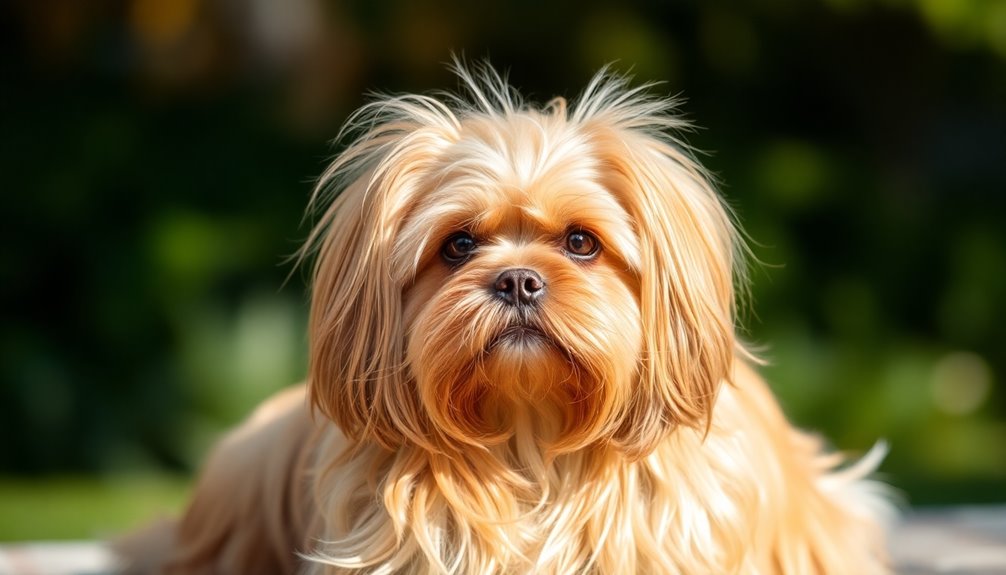
When you look at a Lhasa Apso, you'll notice its small yet sturdy build, standing between 9 to 11 inches tall and weighing anywhere from 10 to 18 pounds. Their long, flowing double coat comes in a variety of colors, adding to their regal appearance. This beautiful coat requires regular grooming to keep it in top shape and free from mats. Additionally, their average weight typically ranges between 13 to 15 lbs, which is ideal for various living situations.
Size, weight, and coat details
The Lhasa Apso is a compact and sturdy dog that stands between 9 to 11 inches tall and weighs between 12 to 18 pounds. Both males and females fall within this height and weight range, making them suitable companions for families and individuals alike. Their sturdy, well-proportioned build contributes to their graceful appearance.
When it comes to weight, the average Lhasa Apso typically ranges from 12 to 18 pounds (5.4 to 8.2 kilograms). Several factors influence this, including genetics, diet, exercise level, and overall health. It's worth noting that individual variations can occur, but their manageable size makes them easily portable, perfect for those who enjoy taking their dogs on outings.
In terms of coat color, Lhasa Apsos come in a variety of shades, including gold, honey, black, white, and parti-color. All colors are accepted, adding to the breed's distinctive charm. While there's no specific color preference in breed standards, their unique coat colors enhance their regal appearance. Additionally, Lhasa Apsos are known for their long, luxurious coats, which require frequent grooming to maintain their beauty.
Long, Flowing Double Coat
Elegance characterizes the Lhasa Apso's long, flowing double coat, which is one of its most striking physical features. This coat comes in a variety of colors, including black, brown, cream, white, and gold, as well as unique shades like silver. The coat can be straight or wavy, consisting of a dense undercoat that offers warmth and a long, airy outer coat that draws admiration.
To maintain this luxurious coat, daily brushing is crucial to prevent matting and tangling. Regular bathing, ideally every 1-2 weeks, keeps the coat clean and healthy. You'll want to pay special attention to the areas around the feet and the longer coat, ensuring they remain tidy.
Consider using anti-static sprays and hydrating conditioners to manage the coat effectively. Styling is also essential; you'll typically part the coat down the center and may use barrettes or braids to manage the hair around the eyes.
For those who prefer a polished look or show their Lhasa Apso, professional grooming services can be invaluable, ensuring the coat remains as regal as the dog itself. Additionally, these grooming practices are vital for the health of the Lhasa Apso's long, double coat, which can be prone to matting without proper care.
Temperament and Personality
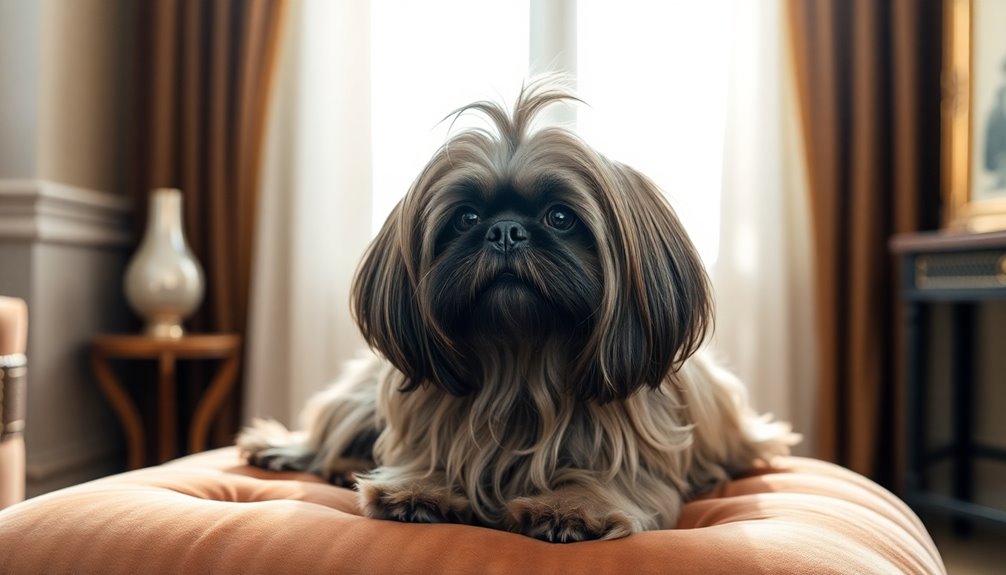
When you think about a Lhasa Apso's temperament, you'll find a blend of playfulness and protectiveness that makes them unique companions. They adapt well to families, individuals, and even other pets, showcasing their affectionate nature. Their loyalty ensures they keep a watchful eye on those they love, making them devoted guardians. This breed's independent spirit allows them to enjoy their own company while still being attentive to their family.
Playful yet Protective Nature
With a unique blend of playfulness and protectiveness, Lhasa Apsos make remarkable companions. These affectionate dogs are loyal to their family members, showcasing a fun-loving spirit without requiring excessive exercise.
Their medium energy level means you can enjoy playful moments without feeling overwhelmed. Intelligent and quick learners, they respond well to positive reinforcement, though their independent streak can sometimes lead to stubbornness. Their independent nature can make training a bit of a challenge, but patience and consistency yield positive results.
As guardians, Lhasa Apsos are naturally alert and vigilant, making them excellent watchdogs. They often display a reserved demeanor around strangers, enhancing their protective instincts. While they're not aggressive, they'll bark to alert you of any potential threats, fulfilling their historical role as sentinel dogs in Tibetan monasteries.
Despite their small size, Lhasa Apsos possess a courageous heart, balancing their playful nature with a protective demeanor. Early socialization and consistent training are essential to help them manage their tenacity while maintaining their affectionate side.
With proper guidance, you can nurture their feisty spirit and ensure they remain devoted and loving companions, ready to play or protect as needed.
Suitability for families, individuals, or other pets
Lhasa Apsos are versatile companions, making them suitable for families, individuals, and even homes with other pets. If you're considering one for your family, it's essential to note that Lhasa Apsos can be great with children, provided they receive proper training and socialization. Their compatibility with kids largely depends on the dog's personality and upbringing. Supervision during interactions is crucial, especially with young children, to ensure safe play.
For individuals, Lhasa Apsos adapt well to various living situations, including apartments. They don't need extensive space and are content with short walks and indoor activities. Their independent nature means they won't suffer from separation anxiety, making them ideal for busy lifestyles. Additionally, their assertive temperament can help them navigate social interactions more confidently, but it's important to manage it appropriately.
When it comes to other pets, early socialization is key. Lhasa Apsos can coexist peacefully with other animals if introduced gradually. While they might be wary of strangers, consistent training and positive reinforcement can help manage their interactions.
With the right approach, you'll find that Lhasa Apsos form deep bonds with their families, showcasing loyalty and affection that enriches any household.
Health and Lifespan

When it comes to your Lhasa Apso's health and lifespan, you're looking at an average of 12 to 15 years, with some living up to 20 years. However, be aware of common health issues like hip dysplasia and eye conditions that can affect their quality of life. Regular vet check-ups are essential for early detection of health issues that can prolong their lifespan.
Typical lifespan of the breed
The average lifespan of a Lhasa Apso typically ranges from 12 to 15 years, though many can live well into their late teens or even surpass 20 years. This impressive longevity is partly due to their smaller size, which often contributes to fewer health issues. Additionally, Lhasa Apsos are known to have long lifespans compared to other breeds, which is a testament to their overall resilience.
However, individual health and care play crucial roles in determining how long your Lhasa Apso will thrive. Genetics significantly influence their lifespan, so it's essential to consider the lineage of your dog.
A balanced diet is vital; feeding them high-quality dog food helps prevent obesity and associated health problems. Regular exercise keeps them fit and supports cardiovascular health, while mental stimulation through engaging activities contributes to their overall well-being.
Pay attention to their living conditions and stress levels, as these environmental factors can also impact their lifespan. Regular veterinary check-ups are critical for monitoring any health concerns and making necessary adjustments in diet and exercise as your dog ages.
Common health concerns or genetic predispositions
Many Lhasa Apsos face specific health concerns and genetic predispositions that potential owners should be aware of. One significant issue is hemophilia B, a hereditary condition that leads to excessive bleeding, particularly in males. Dogs with severe factor IX deficiency often struggle with anemia, weakness, and lethargy. Unfortunately, those with less than 1% activity frequently face mortality shortly after birth. This condition is related to factor IX deficiency, which is crucial for proper blood coagulation.
Skeletal issues also pose risks, including chondrodystrophy and intervertebral disc disease, which can lead to debilitating spinal problems. Hip dysplasia is another inherited concern that can result in arthritis if not managed.
Regular care for their eyes, ears, and skin is essential due to their physical traits. Lhasa Apsos may suffer from eye conditions like progressive degeneration and are prone to ear infections from their feathered ears.
Additionally, dental disease affects around 80% of dogs by age two, making it a pressing concern for this breed.
Lastly, they're susceptible to infections and inherited diseases like glomerulonephropathy, which can lead to kidney failure. Early detection and management of these issues are crucial to ensuring your Lhasa Apso lives a long, healthy life.
Tips for maintaining health and wellness
Maintaining your Lhasa Apso's health and wellness is vital for ensuring a long and happy life. Start with a balanced diet rich in high-quality proteins and fats, which are essential for healthy skin and fur. Consult your veterinarian to find the best food suited for your dog's age, size, and activity level.
Don't forget about Omega-3 fatty acids; they support overall health, including skin and heart health. Incorporating natural ingredients in their diet can further enhance their well-being.
Grooming is equally important. Bathe your Lhasa Apso every two to four weeks with a gentle shampoo, and brush their fur regularly to prevent matting. For long coats, aim for daily brushing and use detangling sprays as needed. Regular grooming is particularly important for maintaining their silky coat, which helps prevent matting and keeps them looking their best.
Exercise is crucial too. Engage in medium-level activities, like quick walks and playtime, tailored to your dog's age and health. A fenced yard can be a great space for them to run.
Lastly, keep up with regular veterinary check-ups, daily teeth brushing, and nail clipping every three to four weeks. Creating a safe, clean environment can significantly enhance their overall well-being and happiness.
Care Requirements
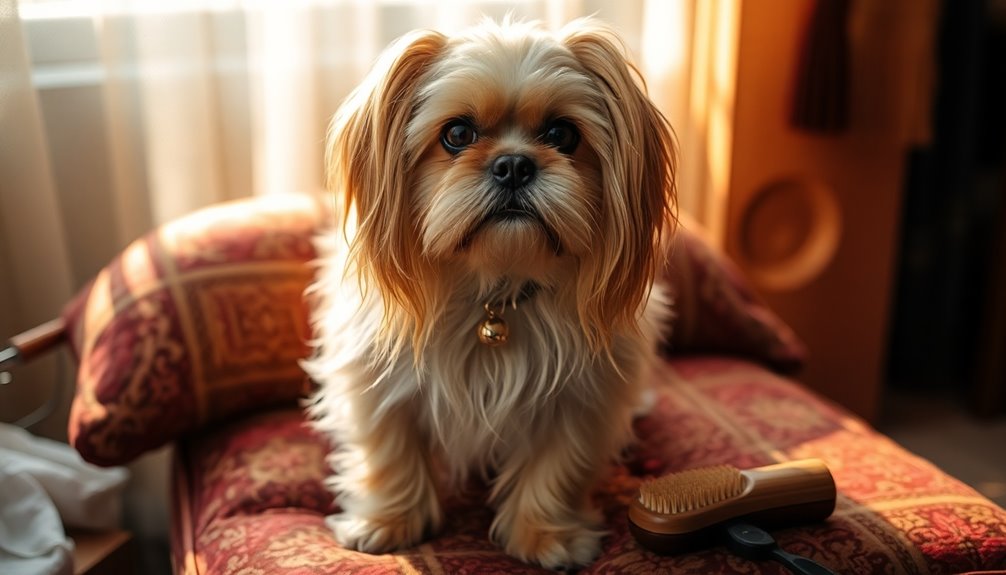
Caring for your Lhasa Apso involves regular brushing to maintain their beautiful coat and prevent tangles. Additionally, their long, flowing coats require daily grooming to prevent matting and keep them looking their best. You'll also need to ensure they get moderate exercise to match their energy levels, keeping them happy and healthy. Lastly, paying attention to their diet with high-quality food will support their overall well-being.
Regular Brushing Required
To keep your Lhasa Apso's coat healthy and free from mats, daily brushing is essential. This routine prevents tangles and ensures that you reach all the way down to the skin, which is crucial given their dense coat. Regular ear checks and cleaning promote air circulation, which is especially important for preventing ear health issues.
Use a pin brush or a slicker brush for effective grooming, and don't forget a wide-toothed comb for those tricky spots. Start brushing at the head and work your way down to the tail, paying close attention to sensitive areas like behind the ears and under the arms.
If your Lhasa Apso's coat is shorter, you might brush 3-4 times a week, but daily is ideal. Always mist their coat lightly with a hydrating spray before brushing; a dry coat can lead to breakage and discomfort.
Regular baths are also helpful in preventing mats, especially if you dry and comb thoroughly afterward.
Exercise requirements and energy levels
Your Lhasa Apso requires daily exercise of 30 minutes to 1 hour, which can be met through walks and playful romps. This moderate physical activity is essential for maintaining fitness and preventing obesity, while also curbing behavioral issues that arise from boredom or excess energy. Regular physical activity helps prevent obesity in Lhasa Apsos, ensuring they remain healthy and active.
Incorporate activities like moderate walking, light agility exercises, and interactive games into their routine. Mental stimulation is equally important, so consider training sessions or puzzle feeders to keep their minds engaged.
Remember to tailor the exercise to their age; puppies need short, gentle sessions, while seniors benefit from a more relaxed routine.
Always be mindful of the weather—avoid overheating by exercising during cooler parts of the day and ensuring they've plenty of water. If the weather's bad, indoor activities like hide and seek or fetch can be great alternatives.
Watch for signs of adequate exercise, such as contentment and a healthy appetite, and balance their activity with relaxation time for their overall well-being.
Feeding tips and diet recommendations
When it comes to feeding your Lhasa Apso, understanding their nutritional needs is crucial for their health and longevity.
Start with high-quality protein sources to support muscle maintenance and growth. Include healthy fats like fish oil and flaxseed for energy and a shiny coat. Complex carbohydrates from whole grains will provide sustained energy and aid digestion. Don't forget essential vitamins and minerals, such as calcium, phosphorus, and vitamins A and E, to keep your pup thriving. High-quality protein sources are essential for muscle health and skin quality.
On average, an adult Lhasa Apso needs about 30 calories per pound of body weight daily, translating to roughly ¾ to 1 cup of dry dog food, depending on size, age, and activity level.
Split their meals into two servings daily for adults; puppies need more frequent feedings with specially formulated puppy food until they're 10-12 months old.
Ensure your Lhasa has constant access to fresh, clean water and consider wet dog food to boost hydration.
Treats can be a nice addition but should remain under 10% of their daily caloric intake, so choose healthy options and avoid toxic human foods like chocolate and onions.
Always consult your vet for tailored feeding advice.
Training and Socialization
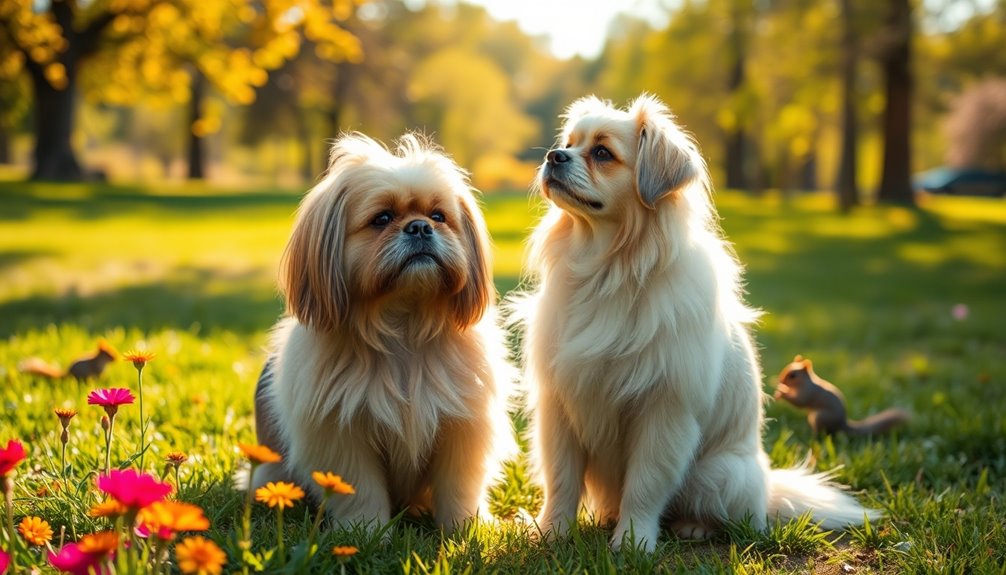
Training a Lhasa Apso can be a rewarding experience, but you should be prepared for their moderately independent nature. Gradually introducing them to new friends is crucial for their social development, and you'll need to be patient with housebreaking challenges. Establishing clear boundaries and expectations during training helps foster good behavior habits that will benefit your Lhasa Apso in the long run.
Moderately Independent Training Style
The Lhasa Apso's independent nature can make training a unique experience that requires a moderately independent approach. You'll find that positive reinforcement works wonders; use treats, praise, and affection to reward good behavior. Additionally, open communication with your dog can enhance the training experience and strengthen your bond.
Avoid punishment—it's more effective to ignore failures and focus on the successes. Clicker training or a consistent sound can help mark desired actions, making your commands clearer.
Keep training sessions short to maintain your dog's interest, and opt for regular kibble or low-calorie treats to prevent weight issues. Patience and consistency are key, as the Lhasa Apso's independence can be mistaken for stubbornness.
Channel their natural alertness positively, especially during obedience training. Use gentle and clear commands to guide your pup, and remember to avoid frustration; your dog can sense your stress.
Begin training in quiet environments with minimal distractions, and gradually introduce new locations to reinforce learned behaviors. Consistent verbal cues, like "Shake!" or creative alternatives, will help your dog understand your expectations.
Monitor their body language to ensure they're comfortable and not overwhelmed. With understanding and dedication, you'll cultivate a well-trained, loyal companion. Additionally, socialization is key to developing a well-adjusted temperament, so make sure to expose your Lhasa Apso to various environments and experiences.
Gradual Introductions to New Friends
Introducing your Lhasa Apso to new friends is essential for their social development and emotional well-being. Start during the critical socialization period of 3-16 weeks, exposing your puppy to various people, including children, the elderly, and individuals in uniforms. Ensure these interactions are positive and controlled to prevent overwhelming your pup.
Invite friends and family over, allowing your Lhasa Apso to meet them in a familiar environment. Use positive reinforcement techniques, like treats and praise, to encourage good behavior during introductions. Consistency in training helps reinforce desired behaviors, making each interaction smoother.
When it comes to other dogs and animals, introduce them under controlled circumstances. Ensure the other pets are well-behaved and vaccinated. Begin with short, supervised interactions, gradually increasing the duration as your puppy becomes more comfortable.
Monitor your Lhasa Apso's body language closely. If they seem scared or overwhelmed, remove them from the situation.
It's crucial to create positive experiences and follow up any negative incidents with rewarding interactions. By managing these introductions carefully, you'll help your Lhasa Apso grow into a well-rounded, confident companion, ready to embrace new friends and experiences.
Housebreaking Difficulties
Housebreaking can be one of the most challenging aspects of raising a Lhasa Apso, especially when combined with their need for socialization. To start, consider crate training. It provides a safe space and helps prevent accidents indoors. Place the crate in a busy area, making it easier for your puppy to communicate its need to go outside. A crate serves as a secure environment during stress, which can help your puppy feel more comfortable during the housebreaking process. Additionally, using a consistent feeding schedule can aid in establishing a routine for bathroom breaks.
Designate a specific potty area outdoors, so your Lhasa Apso learns where to relieve itself. Use tethering or gating to keep your puppy close, allowing you to monitor its body language for signs it needs to go. Remember, no punishment for accidents; this can lead to fear and confusion.
Establish a consistent schedule for feeding and bathroom breaks. Use clear commands and always reward good behavior with praise or treats. Clicker training can help mark the desired behavior effectively.
Start socialization early, exposing your puppy to various environments and people. Keep training sessions short and engaging, and be patient as your Lhasa Apso learns. Each puppy progresses at its own pace, so adjusting your methods is key to success in housebreaking.
Ideal Living Environment
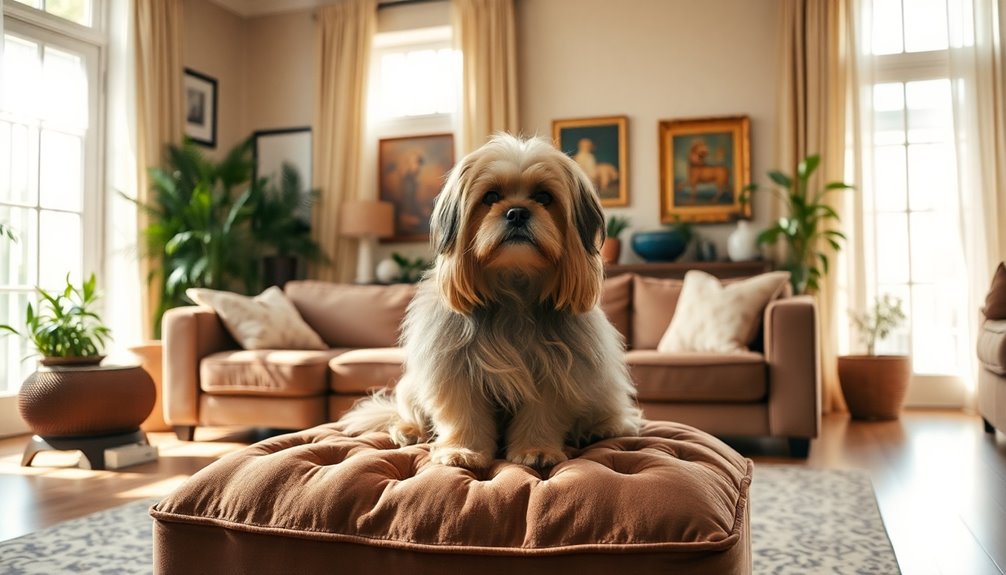
To create the ideal living environment for your Lhasa Apso, focus on a small home with cozy spaces where they can feel secure. These dogs thrive in cooler, dry climates, so ensure your space provides comfort and protection from extreme temperatures. A warm, inviting atmosphere will help your regal companion flourish and feel at home. Additionally, providing dedicated spaces for their comfort, such as a bed and toys, will enhance their happiness and well-being.
Small Home With Cozy Space
Creating a cozy space for your Lhasa Apso in a small home or apartment isn't only possible but also rewarding. These small dogs, weighing between 12-18 pounds, adapt well to compact living environments, as long as you provide them with a dedicated area for their bed, toys, and water.
Since they originally served as guardian dogs, your Lhasa Apso will appreciate having a spot to observe their surroundings and feel secure.
To keep your pup happy, ensure your household is calm, as they thrive in peaceful settings. Regular exercise is essential, so incorporate short daily walks and indoor playtime to meet their moderate activity needs.
Engage them with puzzle toys and interactive games to stimulate their minds.
Socialization is vital; start early to help them feel comfortable around different people and environments. Lhasa Apsos dislike being alone for long periods, so include them in your daily activities whenever possible.
With consistent training and clear boundaries, you can create a harmonious environment that allows your loyal companion to flourish, even in a small space.
Prefers Cooler, Dry Climates
Lhasa Apsos thrive in cooler, dry climates, where their thick double coat can truly shine. Originating from the extreme temperatures of Tibet, these dogs are built to handle the cold. Their dense, weatherproof fur provides excellent insulation against frigid temperatures while also protecting them from harsh sunlight.
You'll find that your Lhasa Apso is most comfortable in cooler environments, and they can adapt well to moderate temperatures. However, heat can pose a challenge. With their short muzzles and smaller airways, they may struggle to breathe in hot weather. To keep your Lhasa safe, avoid excessive exercise on warm days and always provide access to shade and cooler areas. Plan outdoor activities during the cooler parts of the day.
In addition to temperature, consider their grooming needs. Regular brushing helps maintain their coat and ensures they stay comfortable in varying climates. Additionally, consistent grooming is essential due to their long, dense coat that requires daily attention.
Your Lhasa will also benefit from consistent training and socialization, particularly if adjusting to new environments. Ultimately, a stable, predictable living situation will help your loyal guardian thrive.
Ancient Tibetan Royal Companions
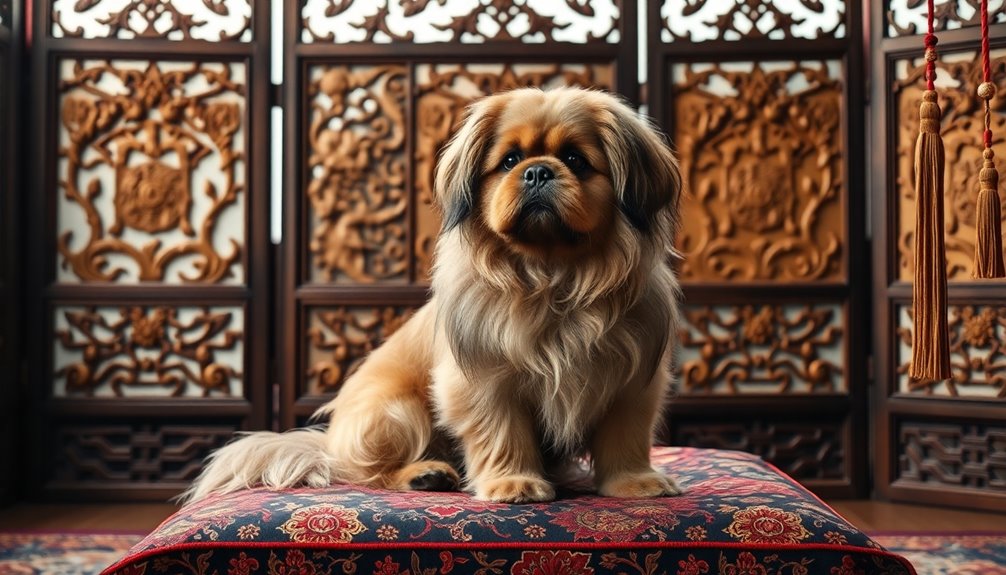
When you think about the Lhasa Apso, consider its historical role as a royal companion to the Dalai Lamas. These dogs weren't just pets; they were cherished guardians and symbols of nobility in Tibetan culture. You might even recognize one as a star in Hollywood's 'Little Buddha', showcasing their enduring legacy and connection to spirituality. Their average lifespan of 12-15 years also reflects their resilience and adaptability as beloved companions throughout history.
Royal Companions of Dalai Lamas
Throughout history, the Lhasa Apso has served as a regal companion to the Dalai Lamas, embodying loyalty and spiritual significance. Originating in Tibet over a thousand years ago, these dogs were bred by Tibetan monks in Himalayan monasteries. They held a sacred place in Lamaist myth, often linked to the mythical Snow Lion, Tibet's national symbol.
As watchdogs and companions, Lhasa Apsos protected Tibetan nobles and spiritual leaders. They were frequently gifted to influential figures, including the emperor of China, reinforcing their status. The Dalai Lama, a significant breeder and giver of Lhasa Apsos, highlighted their cultural importance. When you received one as a gift, it was believed to bring good fortune. Their alert nature not only made them excellent watchdogs but also contributed to their revered status among Tibetan nobility.
Lhasa Apsos were thought to possess spiritual powers, capable of detecting negative energies and warding off malevolent forces with their alert barks. Their role extended to the belief in reincarnation, with the souls of lamas sometimes reborn as these dogs.
In Tibetan Buddhism, they occupy a special place in the spiritual realm, acting as both guardians and loyal companions to the Dalai Lamas, enriching the cultural tapestry of Tibet.
Hollywood's 'Little Buddha' Star
In the world of cinema, the Lhasa Apso has made a memorable appearance as a symbol of Tibetan culture and spirituality in the film "Little Buddha." This 1993 movie, directed by Bernardo Bertolucci, features a Lhasa Apso named Lama Norbu, who not only captivates audiences with his charm but also serves as a bridge between the ancient traditions of Tibet and the modern world.
Historically, these regal dogs, known as Apso Seng Kyi or "bearded lion dogs," were bred to protect Tibetan monasteries and homes of nobility. Their acute hearing and sharp barks made them excellent sentinels, often working alongside Tibetan Mastiffs to secure sacred spaces. Furthermore, their intelligent and independent nature allows them to adapt well to various living situations, making them suitable companions for many families.
In Tibetan culture, Lhasa Apsos are considered sacred, believed to bring good luck, and even thought to temporarily house the souls of deceased Dalai Lamas. As gifts to leaders and potentates, their significance transcends mere companionship.
With their elegant appearance and loyal nature, Lhasa Apsos form deep bonds with families, making them not just guardians but also cherished companions, embodying the spirit of Tibet in both ancient and contemporary narratives.
Ideal for Apartment Living?
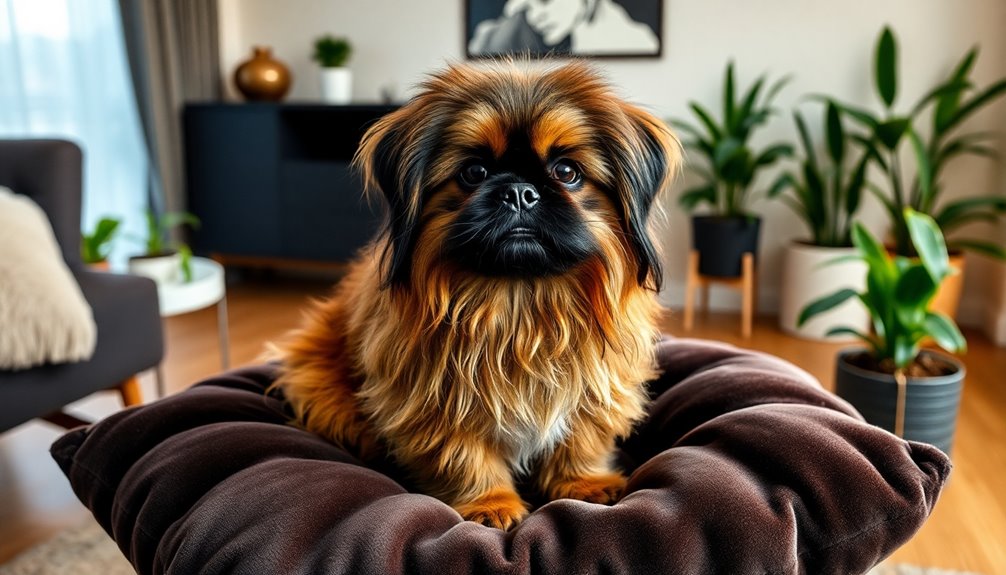
If you're considering a Lhasa Apso for apartment living, you'll find they make excellent companions, especially for seniors.
Their grooming needs do require some time commitment, but their small size and minimal exercise requirements make them manageable in a cozy space. Additionally, their average lifespan of 12 to 14 years means they can be a long-term furry friend.
Plus, their loving nature can bring joy and warmth to your home without overwhelming it.
Great for Seniors' Companionship
With their loyal and gentle nature, Lhasa Apsos make excellent companions for seniors, especially in apartment settings. They thrive on forming deep bonds with their human companions, offering unwavering loyalty and affection. You'll find them happy to sit in your lap or lie at your feet, providing comfort and warmth.
Their calm demeanor is perfect for seniors who need a quiet companion, making them adaptable whether you live alone or have grandchildren around. As they age, Lhasa Apsos may develop age-related health issues that require attention, but their affectionate nature remains unchanged.
Lhasa Apsos are well-suited for apartment living due to their small size and moderate exercise needs. They don't require extensive space but do need enough room to play and move comfortably. Short daily walks and some playtime within your apartment typically suffice for their activity requirements.
To keep them mentally stimulated, consider incorporating puzzle toys and interactive games into your routine.
With proper attention, Lhasa Apsos can adjust well to the sounds and routines of apartment life. As they grow older, they may need gentler activities, but their affectionate nature ensures they'll remain a loyal companion, enriching your life with their presence.
Grooming Needs and Time Commitment
Grooming a Lhasa Apso may seem like a daunting task, but it's manageable even in an apartment setting. Daily brushing is essential to prevent tangles and matting, especially with their long coats. You'll need to dedicate a few minutes each day, and regular bathing—from once a week to every six weeks—will keep their coat clean and healthy. Using a slicker brush to remove debris and loose hairs from the undercoat can significantly enhance your grooming routine. It's important to remember that regular cleaning of their grooming tools can prevent the transfer of bacteria and irritants to their skin.
Pay attention to their feet and longer coat areas to avoid dirt buildup. Using a rounded tip metal pin comb or a slicker brush can help you tackle tangles and loose hairs effectively. Always mist their coat with a conditioner or hydrating spray before brushing to minimize static and breakage.
For apartment living, consider shorter trims to reduce grooming time if needed. Consistent grooming not only maintains cleanliness but also enhances your dog's comfort and health. Make sure to check for mats and tangles promptly to prevent more significant issues.
Regular dental care and veterinary check-ups are vital for their overall well-being. With commitment and the right tools, you can ensure your Lhasa Apso remains a regal and loyal companion while thriving in your apartment.
Frequently Asked Questions
How Much Exercise Do Lhasa Apsos Need Daily?
Lhasa Apsos need about 30 minutes of exercise each day to stay healthy and happy.
You can break this up into walks and playtime to meet their energy levels. Daily walks are essential, even if they're short, to keep them engaged physically and mentally.
Incorporating gentle activities like indoor play or short agility exercises can also help. Adjust the routine based on your dog's age and health to ensure they stay active without overdoing it.
Are Lhasa Apsos Good With Children and Other Pets?
Lhasa Apsos can be great with children and other pets if you train and socialize them properly.
They're loyal and affectionate, but they may not tolerate rough play, so supervision during interactions is crucial.
Introducing them to kids and pets early, along with gentle, calm interactions, sets the stage for a positive relationship.
Remember to teach your children how to engage respectfully, ensuring a harmonious environment for everyone involved.
What Grooming Tools Are Essential for Lhasa Apsos?
When grooming your dog, you'll need some essential tools to keep their coat healthy and manageable.
Start with a good comb, like the Chris Christensen Butter Comb, for detangling. A slicker brush helps with matting, while a pin brush works well for legs and feet.
Don't forget to have nail trimmers for maintaining nail length, and ear care tools to ensure proper hygiene.
Regular brushing and bathing will also keep their coat in top shape.
Can Lhasa Apsos Be Left Alone for Long Periods?
Yes, Lhasa Apsos can be left alone for long periods, thanks to their independent nature.
They often spend their time sleeping while you're away, which helps reduce separation anxiety.
However, it's important to create a safe environment for them, like a crate or pen, to avoid potential accidents.
Make sure to provide regular exercise and a consistent routine to keep them happy and healthy during those alone times.
What Common Behavioral Issues Do Lhasa Apsos Face?
Lhasa Apsos often face behavioral issues like suspicion toward strangers, which can lead to defensiveness or biting without proper socialization.
Their strong-willed temperament may result in dominance if you don't establish clear leadership.
Training can be tricky since they get bored easily and resist harsh methods, requiring short sessions and positive reinforcement.
Additionally, they can exhibit jealousy around other pets and defensiveness around children, making early socialization crucial for balanced behavior.
Conclusion
In conclusion, the Lhasa Apso isn't just a dog; it's a loyal companion with a regal spirit. Their unique blend of charm, intelligence, and adaptability makes them perfect for various living situations, including apartments. With proper training and socialization, you'll discover their affectionate nature and protective instincts. If you're ready to welcome a devoted guardian into your life, the Lhasa Apso might just be the perfect addition to your family.



